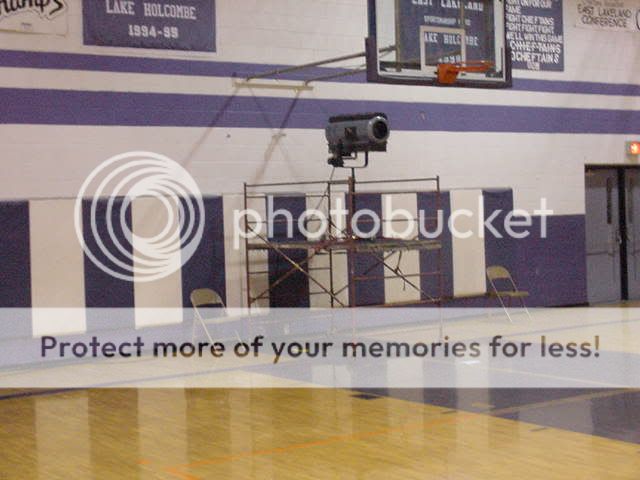I help out with a small-school gymnatorium theater program with very limited theatrical resources. We don't have balconies, catwalks, a control room, rigging or a fly system, etc etc.
One of the challenges is that if we want to use a followspot, we cannot get it up in the air very high without serious safety/fall risks for the student operators. A raised platform about five feet off the floor is about the best we can manage:

In general this works because it is not blocked by the audience, who sit in folding chairs on the gym floor in front of the spot, but it is blinding for the actors because it shines head-on about level with the stage into their face. It's pretty much impossible to get it up overhead.
,
One possibility that MIGHT work is a ceiling mounted motor-steered followspot, with motorized iris and focus, and solenoid operated color gels.
This could be manually controlled from a console in the lap of a student with an analog joystick, sliders for iris / focus, and toggle switches for in/out movement of the color gels. (Maybe we could adapt a USB XBOX controller for the job...)
I've been looking around for something like this that could adapt onto the top of an Altman Luminator followspot to motorize the various control levers but so far it appears nothing exists to do this.
,
There is an X-Y motorizing yoke for ellipsoidal fixtures but it is quite expensive for our limited budget, in the $3500+ range for one fully automated yoke, not including the fixture itself.
City Theatrical - AutoYoke for S4 / Strand SL
CITY THEATRICAL
Pan / Tilt AutoYoke - $2350
AutoIris control for S4 - $475
AutoFocus control for S4 - $650
I have no experience with the ETC S4. I have no idea if it could be bright enough to used by itself as a followspot.
,
The alternative is a small fully packaged followspot for around $1000-2000, but I do not know if these have the precise control needed to do accurate slow tracking of actors on stage.
Possibilities:
Chauvet - Legend 1200E Spot
Products Legend? 1200E Spot | CHAUVET Lighting
American DJ - Accu-Spot 575
American DJ Homepage
Elektralite - My575.3
http://www.myelektralite.com/m/p/ELE_BRC_090204_0001.pdf
Mega Lite - Axis 600
Mega-Lite | The Power of Light
Also I don't know if the beam diameter of these would be big enough or the lamp bright enough, or if it is just meant to be used as a moving-lighted-circle fog-beam dance-party style effect, rather than for serious theatrical lighting use.
,
And finally, I cannot find any source for a DMX manual hand-control system for live steering of a motorized followspot.
Either nobody has thought of trying to do this before, or it has been tried but does not work very well.
I'm leaning in the direction that this is a novel idea that nobody has tried. "Theater followspots are hand operated, with someone standing behind it waggling the thing around by hand, and always will be, period!"
- Dale Mahalko
One of the challenges is that if we want to use a followspot, we cannot get it up in the air very high without serious safety/fall risks for the student operators. A raised platform about five feet off the floor is about the best we can manage:

In general this works because it is not blocked by the audience, who sit in folding chairs on the gym floor in front of the spot, but it is blinding for the actors because it shines head-on about level with the stage into their face. It's pretty much impossible to get it up overhead.
,
One possibility that MIGHT work is a ceiling mounted motor-steered followspot, with motorized iris and focus, and solenoid operated color gels.
This could be manually controlled from a console in the lap of a student with an analog joystick, sliders for iris / focus, and toggle switches for in/out movement of the color gels. (Maybe we could adapt a USB XBOX controller for the job...)
I've been looking around for something like this that could adapt onto the top of an Altman Luminator followspot to motorize the various control levers but so far it appears nothing exists to do this.
,
There is an X-Y motorizing yoke for ellipsoidal fixtures but it is quite expensive for our limited budget, in the $3500+ range for one fully automated yoke, not including the fixture itself.
City Theatrical - AutoYoke for S4 / Strand SL
CITY THEATRICAL
Pan / Tilt AutoYoke - $2350
AutoIris control for S4 - $475
AutoFocus control for S4 - $650
I have no experience with the ETC S4. I have no idea if it could be bright enough to used by itself as a followspot.
,
The alternative is a small fully packaged followspot for around $1000-2000, but I do not know if these have the precise control needed to do accurate slow tracking of actors on stage.
Possibilities:
Chauvet - Legend 1200E Spot
Products Legend? 1200E Spot | CHAUVET Lighting
American DJ - Accu-Spot 575
American DJ Homepage
Elektralite - My575.3
http://www.myelektralite.com/m/p/ELE_BRC_090204_0001.pdf
Mega Lite - Axis 600
Mega-Lite | The Power of Light
Also I don't know if the beam diameter of these would be big enough or the lamp bright enough, or if it is just meant to be used as a moving-lighted-circle fog-beam dance-party style effect, rather than for serious theatrical lighting use.
,
And finally, I cannot find any source for a DMX manual hand-control system for live steering of a motorized followspot.
Either nobody has thought of trying to do this before, or it has been tried but does not work very well.
I'm leaning in the direction that this is a novel idea that nobody has tried. "Theater followspots are hand operated, with someone standing behind it waggling the thing around by hand, and always will be, period!"
- Dale Mahalko


